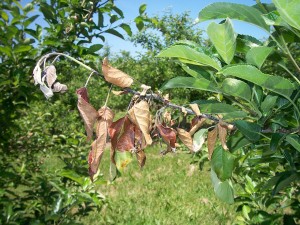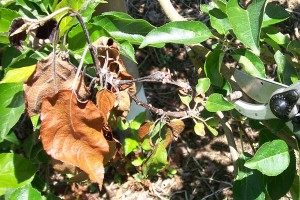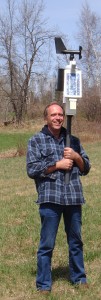Understanding CougarBlight, the model for blossom blight used in NEWA, will greatly improve your ability to protect your orchard from fire blight. Getting the most out of CougarBlight, a recent article in Good Fruit Grower by Melissa Hansen on Feb 17, 2015, summarized a presentation at the annual meeting of the Washington State Horticultural Association given by Tim Smith, Washington State University Extension Educator for Douglas and Chelan counties and our adviser for the NEWA fire blight model.

Fire blight strike coming in from a blossom infection. Note the dead flower cluster hanging below the shoot.
I have excerpted portions of the article here to help Northeastern apple and pear growers use and understand NEWA’s fire blight tool. Read Hansen’s entire article at http://www.goodfruit.com/getting-the-most-out-of-cougarblight/
Understanding CougarBlight
1. It does not indicate that fire blight will occur in your orchard.
If you don’t have the bacteria in your orchard, there’s nothing there to create the disease, Tim Smith said.
2. When weather conditions occur that trigger fire blight, somebody is getting hit.
Every time the model says that conditions are ripe, somebody is getting hit, though it might not be you. “The model never misses,” said Smith, noting that eastern Washington, with its dry climate, is blessed to be in a low-fire blight environment.
3. It is a flower infection model only.
The flower is the most common site for bacteria in the tree and infections start with the flower. “The model has nothing to do with shoot or vegetative infection,” he said, adding that the model begins when flowering starts and continues as long as there are flowers or when flowering resumes for second bloom. “So you have to be looking for when the first true flowers open and then start counting. Some of the worst infections have occurred from the secondary or side blooms.”
Smith warns growers not to discount secondary bloom as a source of primary infection. “Odds are that the weather is warmer during secondary bloom, which the disease likes. Also, remember that young trees get a lot of secondary bloom.”
4. It models the rate at which fire blight bacteria can grow, not the infection process.
When trees bloom, bacteria begin to ooze from cankers that developed from strikes the previous season. Flies are drawn to the musty, sweet goo that tastes like molasses (Smith knows because he has tried it), and they deposit bits of goo and bacteria all over the tree, including stigma surfaces.
Infection can occur if moisture washes bacteria down from the stigma to the young fruitlet and if the bacteria population is high enough. Small populations don’t trigger a pathogenic outbreak but large ones do.
Bacteria multiply at a rate that’s governed by temperature and resources, Smith explained. The more moisture and food the bacteria have available, the faster they can grow at a given temperature. Blight bacteria can grow in a temperature range of 50°F to 90°F, and do best from 78°F to 90°F. Growth rate slows above 90°F and stops at around 100°F.
Past models relied on mean temperatures (average between the high and low for the day), but Smith says they were too crude. Dr. Larry Pusey, retired U.S. Department of Agriculture researcher, found that peak temperatures were more important than mean temperatures relative to rate of blight bacteria growth. “It turns out that just one day at 88°F is enough to build up a colony,” said Smith.
5. You must identify your orchard fire blight risk.
To use the model, you must first determine fire blight pressure (high, medium, or low) for your orchard. “It’s very important to know how much fire blight is in your vicinity because it makes a huge difference in the temperatures needed to trigger infection,” he said.

NEWA has a drop down list for the fire blight history in your orchard. It defaults to the medium level.
Smith suggested that a guideline of 400 feet adjacent to the orchard be used in determining fire blight in the neighborhood. If you had no fire blight in your orchard and neighborhood last year, risk this year will be low. But a missed canker that wasn’t cut out in the winter can result in an orchard ‘hot spot’ and set the orchard up for a worst-case scenario.
6. The model’s risk value thresholds are to be used as a guideline.
Threshold numbers are not absolute, but should be used as guidelines. Generally, the risk numbers work out well, he said, noting that a high risk number of 299 should not be considered much lower in risk than 301.
7. Moisture triggers fire blight.
Wetting is what triggers the disease, not warm temperatures. Although warm temperatures enable bacteria to grow to high enough numbers that lead to infection, water is needed to complete the infection process, he said. But it’s more than rain that triggers fire blight.
He’s seen serious outbreaks occur from turning on overhead or under-tree sprinkler systems for just three minutes “to see if it’s working right.” Smith cautioned that it’s better to run sprinklers for five hours to completely wash flowers than run them for a few minutes. “Don’t water trees in April; they don’t need water then,” he stressed. “You should be thinking very cautiously about watering in the spring other than for frost control.”
Growers also need to account for dew when considering moisture events. Remote weather stations are usually located outside an orchard so true temperatures can be monitored. Low areas with poor air drainage are where dew often occurs, areas that might not be accounted for in weather station recording. “Every four to five years we have dew-induced fire blight infections,” he said. “We used to think that frost was a component in fire blight, but now we know it was dew that was triggering the infection.”
8. Check the forecasting component of the model.
Smith noted that growers should be sure to look at the (current) and (blossom blight 5-day forecast) when viewing the model. “…to control fire blight well, you have to look at the weather forecast, especially if using organic and biological fire blight agents.” Smith believes that the model’s forecasting risk feature is one of its most important parts.
Tips for controlling fire blight
What should you do this season, if your pome fruit orchard or a neighboring orchard had fire blight last year?
First, make sure all of the blight strikes were cut and removed from the orchard after harvest or during pruning.

Blossom blight strike being pruned out.
Next, put on a copper spray during dormancy, says Tim Smith, Washington State University Extension educator for Douglas and Chelan counties. “Copper sprays have been proven to make a difference in reducing the number of bacteria that make their way to the flowers,” he said.
Biofungicides and biological products have a preventive action and should be applied when the CougarBlight model says risk is coming in the next few days.
Products like Blossom-Protect (Aureobasidium pullulans) and Serenade (Bacillus subtilis) should be applied before it rains and infection takes hold. Also, they usually need reapplying every few days.
“But the day it rains is when growers often respond,” Smith said. In that case, an antibiotic should be applied to combat infection of flowers.
Product labels must be checked when spraying during secondary blooms because many products are restricted for that time period, he said.
Find the NEWA fire blight tool on the Apple Diseases page, http://newa.cornell.edu/index.php?page=apple-diseases. It charts CougarBlight degree hours, wetting events, takes into consideration streptomycin sprays and your bloom date, and will predict appearance of trauma shoot blight symptoms. Contact Dr. Kerik Cox, Extension Tree Fruit Pathologist, Plant Pathology & Plant Molecular Biology, Cornell University, for more information.



